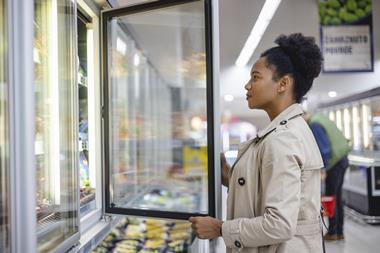Novelties aren't just kids' stuff, says Tim Palmer, but an excuse to tempt adults with something new too
T he pressure to find a new angle that will appeal to fickle consumers is a continual driver of innovation at the novelty end of the market.
The sector encompasses a broad range of products, from top of the range high quality chocolates to character merchandising, seasonal gifts and collectable figures.
"A novelty is something that is innovative and unique," says Lindt's product manager Keri Alcock. "We are good at that. We are the market leader in developing new concepts, particularly for children, but also for adults."
She says the key is to come up with a product that mainstream producers do not offer. It has to be unusual, she believes, and something that people are prepared to pay a bit more for.
"With Lindt, we go for higher quality presentation and use a better quality chocolate than mainstream brands. We innovate through the whole package."
The company is not afraid of experimenting with flavour either. This year its Copper Collection features a range of chocolates flavoured with cinnamon and coriander.
"The introduction of spice gives it a festive feel," says Alcock.
One of its most successful innovations has been its Easter Bunny. From this it developed a Santa Claus, which last year increased sales by 101% on 1999. And for the first time this year its range features a Hallowe'en collection.
Alcock says: "Part of the success of most of these novelties has been that they appeal to a wide range of ages and are not specific to children."
The children's market is, however, a main driver for many novelty products. One of the major successes this year has been the Powerpodz Micro-stars concept, which is a joint venture between Magna Specialist Confectionery and Corinthian.
Magna has created a hollow chocolate pod which contains specially licensed figurines of top footballers, sourced by Corinthian.
Joint managing director Paul Speed says: "Licensed confectionery is a fast growing sector, but licensed products have not penetrated as fast as they have in the toy market because of the powerful confectionery brands."
The Powerpodz Microstars were launched in February and will be followed up next month with Powerpodz PopStars.
Speed believes that within five years the figures will command 2% of the market and be worth £30m-£50m. He has a budget of £4m to support the brand in its first year.
Its primary market is the high street and convenience stores which children themselves go to. The Powerpodz retail for £1.29-£1.49 and there are 63 Microstars in the collection. This number will increase to 120 ahead of next year's World Cup.
The PopStars version for girls will follow a similar trend.
Speed says: "We know what kind of products appeal to children, but we also know they can be very fickle."
Corinthian's research shows that 80% of boys claim that football is their number one interest, and that the same proportion of girls put pop at the top of their list.
Speed is hoping to capitalise on this."We are not really selling confectionery, that is a consolation. The kids see the chocolate as coming free with the product. Our main competition is whatever appeals to the hearts and minds of children. Our marketing is designed to make the product the thing to have in the playground."
David Hill, key account manager at Van Lauren, has identified two important trends that are helping his company. He believes consumers and retailers are looking for higher quality goods as well as something out of the ordinary.
He explains: "We add value to confectionery items by incorporating a gift that can be kept."
His key markets are department stores, for which the company creates a whole range of products. This is a profitable niche in which the major confectionery companies have not yet made inroads.
"They tend to concentrate on brand extensions and keep away from doing something totally new," says Hill.
Van Lauren's range of products includes gift sets of coffee mugs and chocolates, and finger puppets containing 100g of chocolate balls or sugar confectionery.
"The products are generally different and eye catching, and the niches we fill mean we can get to retailers where the big companies are not listed.
"We can also put together products with multiple components, and that does not suit the big players."
Finding a gap in the market and exploiting it has been driving the success of Jelly Belly jelly beans from Goelitz and the company is continually developing novelty packaging.
Recent innovations from Goelitz include the Bean Machine, Juggler and Golfer dispensers for the jelly beans.
{{FOCUS SPECIALS }}
Close menu
- Home
- Retail & Wholesale
-
Products & Suppliers
- Back to parent navigation item
- Products & Suppliers
-
Product Categories:
- Back to parent navigation item
- Product Categories:
- Alcoholic drinks
- Bakery
- Cereals & breakfast
- Cheese
- Chicken & poultry
- Chocolate
- Confectionery
- Crisps, nuts & snacks
- Dairy
- Fish
- Fresh produce
- Frozen
- Household
- Meat
- Own Label
- Sauces & condiments
- Seasonal
- Soft drinks
- Vaping
- Vegan & plant-based
- World foods
- Suppliers
- People
- Reports & Data
-
Topics A-Z
- Back to parent navigation item
- Topics A-Z
-
Popular topics:
- Back to parent navigation item
- Popular topics:
- Cost of living crisis
- Crime
- Deposit Return Schemes
- Finance
- Government & Regulation
- Health
- Inflation
- Loyalty
- Marketing
- Mergers & Acquisitions
- New Product Development
- Sourcing
- Supply chain
- Sustainability & environment
- Technology
- Ultra Processed Foods
- Vaping
- A-Z all topics
- Content by type:
- Events
- Ask iA (beta)
- Subscribe now
Sign in to comment on this article
Not logged in before? Register for FREE guest access today.
You will be able to:
- Read more stories
- Receive daily newsletters
- Comment on stories
Advert













No comments yet